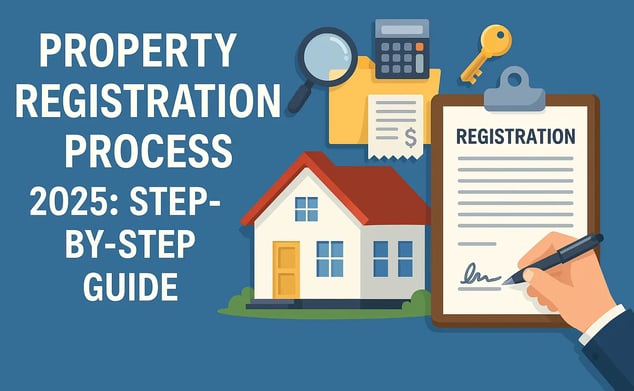Property Registration Process 2025: Step-By-Step Guide
Explore our 2025 step-by-step guide on the property registration process in India. Learn the digital, legal, and practical steps to secure your property.
Archita
4/5/20255 min read


Do you really know what it takes to legally own your dream property?
The property registration process is one of the most crucial steps in ensuring that your property purchase is legally binding and secure. With evolving government policies and increasing digitalization, the process in 2025 has become more streamlined, efficient, and transparent. In this guide, we’ll walk you through the step-by-step property registration process in India, highlighting key steps, best practices, and additional considerations to keep in mind. Whether you’re a first-time buyer or an experienced investor, understanding this process is vital to safeguarding your investment.
Why is Property Registration Important?
Property registration legally transfers ownership from the seller to the buyer. It not only acts as proof of ownership but also helps prevent disputes and fraud. The registration process ensures that all relevant documents are verified and that the transaction complies with local laws and regulations. In 2025, with an increased focus on digital processes and transparency, the registration process has become even more robust, reducing paperwork and saving time.
Step 1: Title Verification and Document Collection
Before any sale deed is drafted, the first and most critical step is to verify the title of the property. This includes checking the ownership history, ensuring there are no encumbrances, and confirming that the property has a clear title.
Title Search: Visit the local sub-registrar office or use online portals provided by state governments to verify property titles.
Document Collection: Gather essential documents such as:
Sale deed from the previous owner
Encumbrance certificate
Approved building plan (for constructed properties)
No Objection Certificates (NOCs) from relevant authorities
Tax receipts and utility bill records
Identity proofs of both the buyer and seller
Step 2: Drafting the Agreement for Sale
Once the title and documents are verified, the next step is to create an agreement for sale between the buyer and seller. This document outlines the terms and conditions of the transaction and serves as an initial binding contract.
Key Elements: The agreement should include details about the property, sale price, payment schedule, possession date, and any contingencies.
Legal Review: It is advisable to have the draft reviewed by a legal expert to ensure that all clauses are fair and protect your interests.
Step 3: Calculation of Stamp Duty and Registration Fees
Stamp duty is a tax imposed by the state government on property transactions, while registration fees cover the cost of recording the transaction. These charges vary from state to state.
Stamp Duty Calculation: Typically based on the property value, location, and type (residential, commercial, etc.).
Registration Fees: Often a fixed percentage of the property value.
Digital Payment: In 2025, many states offer online portals for calculating and paying these fees, making the process smoother and less time-consuming.
Step 4: Drafting the Sale Deed
The sale deed is the primary document that legally transfers property ownership. It is a detailed legal document that includes all aspects of the transaction.
Content of the Sale Deed: This document should clearly state:
Property description and location
Sale price and payment details
Obligations of both the buyer and seller
Signatures and dates
Legal Assistance: Engaging a lawyer to draft or review the sale deed is highly recommended to avoid any future legal disputes.
Step 5: Execution of the Sale Deed
After the sale deed is drafted and mutually agreed upon, it is time to execute the document.
Signing: Both parties must sign the deed in the presence of two witnesses.
Witness Statements: The witnesses should also sign the document, confirming the authenticity of the signatures.
Notarization: Although not always mandatory, notarization of the sale deed adds an extra layer of legal validity.
Step 6: Payment of Stamp Duty and Registration Fees
Once the sale deed is executed, the buyer must pay the required stamp duty and registration fees.
Payment Methods: Payments can be made digitally through state government portals or at designated banks.
Receipts: Keep all payment receipts safe, as these are required during the final registration process.
Step 7: Registration at the Sub-Registrar Office
With all documents in hand and fees paid, the next step is to register the property at the local sub-registrar office.
Booking an Appointment: In many states, appointments can be booked online to avoid long queues.
Document Submission: Submit the sale deed, along with all supporting documents and receipts, at the sub-registrar office.
Verification Process: The sub-registrar verifies the documents, and any discrepancies are addressed before proceeding.
Step 8: Mutation and Updating Property Records
After the property is registered, the mutation process updates the local revenue records to reflect the new ownership.
Mutation Process: This involves updating the title records in the local municipal or revenue office.
Time Frame: The process can take a few weeks to a couple of months, depending on the jurisdiction.
Online Updates: In 2025, many states have digitized the mutation process, making it easier to track and complete.
Step 9: Embracing Digital and E-Registration Innovations
The property registration process has seen significant digital enhancements over the past few years.
E-Registration: Many states now offer end-to-end e-registration systems that allow online submission and verification of documents.
Blockchain Technology: Some pilot projects are experimenting with blockchain for tamper-proof property records.
Automated Notifications: Automated SMS and email alerts keep buyers updated on every step of the process.
Digital Archiving: All records are stored digitally, ensuring that documents are easily retrievable in the future.
NCR Housing in Connection to Property Registration
The National Capital Region (NCR) of India has seen unprecedented growth in property transactions. Due to the high demand for housing in this region, the registration process here has some distinct features:
Higher Stamp Duties: NCR states such as Delhi and its adjoining regions often impose higher stamp duties due to increased property values.
Increased Scrutiny: Given the high investment stakes, property documents in NCR are thoroughly scrutinized for any encumbrances.
Digital Push: Many NCR regions are pioneers in adopting digital registration systems, making the process more efficient.
Special Schemes: The government often introduces special schemes or incentives in the NCR to facilitate faster registration and mutation, further boosting investor confidence.
Understanding the nuances of the property registration process in the NCR is essential, as it can directly influence the ease and cost of acquiring property in one of India’s most competitive real estate markets.
Conclusion
Navigating the property registration process might seem daunting, but breaking it down into clear, manageable steps can simplify the journey significantly. From initial title verification and document collection to executing the sale deed, paying stamp duties, and finally registering the property at the sub-registrar office, each step is designed to ensure that your investment is secure and legally sound.
The added emphasis on digital innovations in 2025 has not only expedited the process but also enhanced transparency and reliability. Whether you’re investing in a bustling metropolis like those in the NCR or exploring emerging markets across India, understanding and following these steps will pave the way for a successful property transaction.
Frequently Asked Questions (FAQs)
Q1. Why is property registration necessary?
A1. Property registration legally transfers ownership, provides proof of title, and protects buyers against disputes and fraudulent transactions.
Q2. What documents are required for property registration?
A2. Essential documents include the title deed, sale deed, encumbrance certificate, approved building plan, NOCs, tax receipts, and identity proofs of the buyer and seller.
Q3. How can I calculate the stamp duty and registration fees?
A3. Stamp duty and registration fees are calculated based on the property value, type, and location. Many state government websites offer online calculators for accurate estimates.
Q4. What is the mutation process?
A4. Mutation is the process of updating local municipal records to reflect the new ownership after property registration, ensuring that all property records are current.
Q5. How has digitalization impacted the property registration process in 2025?
A5. Digital innovations, including e-registration, automated notifications, and digital archiving, have made the process faster, more transparent, and secure, reducing the reliance on manual paperwork.
NCR Housing
Your guide to NCR housing insights and tips.
Subscribe us
© 2025. All rights reserved.
